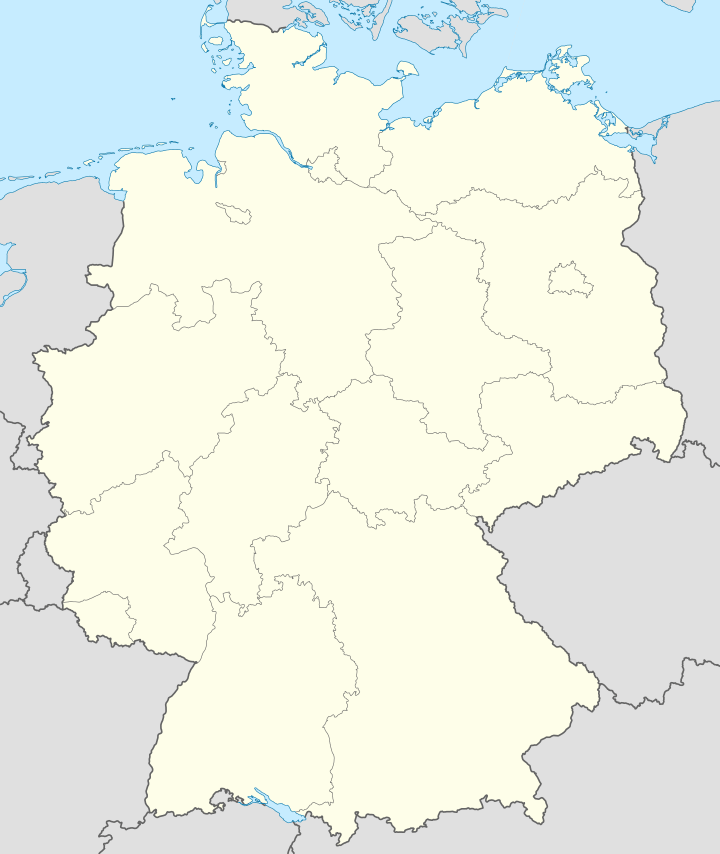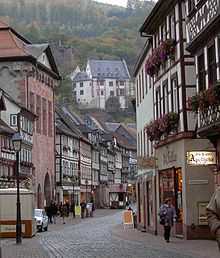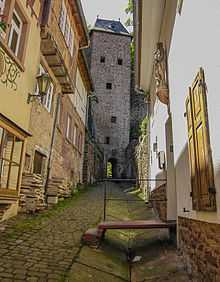Miltenberg
| Miltenberg | ||
|---|---|---|
| ||
 Miltenberg | ||
Location of Miltenberg within Miltenberg district  | ||
| Coordinates: 49°42′14″N 09°15′52″E / 49.70389°N 9.26444°ECoordinates: 49°42′14″N 09°15′52″E / 49.70389°N 9.26444°E | ||
| Country | Germany | |
| State | Bavaria | |
| Admin. region | Unterfranken | |
| District | Miltenberg | |
| Government | ||
| • Mayor | Helmut Demel (Liberale Miltenberger) | |
| Area | ||
| • Total | 60.18 km2 (23.24 sq mi) | |
| Population (2013-12-31)[1] | ||
| • Total | 9,197 | |
| • Density | 150/km2 (400/sq mi) | |
| Time zone | CET/CEST (UTC+1/+2) | |
| Postal codes | 63897 | |
| Dialling codes | 09371 | |
| Vehicle registration | MIL | |
| Website | www.stadt-miltenberg.de | |
Miltenberg is the seat of the like-named district in the Regierungsbezirk of Lower Franconia (Unterfranken) in Bavaria, Germany.
Geography

Location
The historic Miltenberg lies on the Main’s left bank on the “left knee” of the Mainviereck (“Main Square”) between the Spessart and Odenwald ranges. Since the Main riverbed in the Miltenberg area is relatively near the foot of the Odenwald, only a narrow strip of usable land is left, which in bygone centuries was time and again flooded by the Main. The historic centre, which stands on this land, often sustained considerable damage in these floods. Only in the 21st century efficient flood control measures, most of all a wall, have significantly reduced the adverse effects of these floods. Since about the beginning of the 20th century, after buying land from the neighbouring community of Großheubach, Miltenberg has been spreading itself out on the right bank.
History

Even as far back as prehistoric and early historical times, people knew about the strategic importance of the strait at the Main "knee" between the Odenwald and the Spessart, building mighty circular ramparts on the Greinberg above Miltenberg and on the Bürgstadter Berg (hills). About 155 AD, the Romans laid down the almost dead straight "Upper Germanic-Rhaetian Limes" on the Main. Near today’s Miltenberg, the Limes came up against the Main, which from here northwards formed the Roman Empire’s natural border with Germania. Remnants of two Roman castra can be found nearby, one between Miltenberg and Bürgstadt (Kastell Miltenberg-Ost) and the other between Miltenberg and Kleinheubach (Altstadtkastell).[2]

Under the protection of the castle Mildenburg (built about 1200), the town of Miltenberg took hold. It had its first documentary mention in 1237. By about 1379, the two town towers, the Mainz Gate (Mainzer Tor) and the Würzburg Gate (Würzburger Tor) formed the eastern and western boundaries of today’s historic centre, which grew narrow and long between the river and the steep slope. Already by the Middle Ages, Miltenberg's red buntsandstein was highly sought-after, with things such as grindstones and columns being hewn in the surrounding woods. Even before 1319, the Spital St. Peter (hospital) was founded by Archbishop Peter of Aspelt.


Until 1803, Miltenberg belonged to Electoral Mainz. After securalization and the Reichsdeputationshauptschluss, Miltenberg passed to the Principality of Leiningen, with which it was incorporated into the Grand Duchy of Baden in 1806. After having become part of the Grand Duchy of Hesse-Darmstadt in 1810, the town finally became part of Bavaria in 1816.
The so-called Heunensäulen were made near Miltenberg. They are special bunter columns meant for Mainz Cathedral when it was built more than a thousand years ago. The master builder, however, decided that they were not needed, so they never became part of the cathedral. One of them now stands in Mainz’ cathedral square, a gift to the city on the occasion of the cathedral’s thousandth anniversary in 1975. An explanatory plaque has been attached to the column.
Miltenberg has a historic centre featuring many timber-frame houses. In 1912 and 1951, Miltenberg acquired lands on the Main’s right bank to expand the town.
The castle has been under the town’s ownership since 1979. In 2010/2011, the castle was renovated. It now houses a unique museum of icons and contemporary art (Museum.Burg.Miltenberg). In the castle’s inner ward once was the Teutonenstein, a 5 m-tall sandstone column the inscription of which is still a puzzle to this day. The Teutonenstein is now in the Museum.Stadt.Miltenberg at the historic market square.
In 2006, the town made national headlines when parish priest Ulrich Boom rang the bells for 20 minutes during a rally of the far-right National Democratic Party of Germany, thereby disrupting the event.[3] Ulrich Boom later became Auxiliary Bishop.
Incorporations
The following villages have been incorporated into Miltenberg:
- 1 January 1971: Breitendiel
- 1 January 1976: Mainbullau
- 1 January 1976: Schippach (with Berndiel)
- 1 January 1976: Wenschdorf (with Monbrunn)
Politics
Mayors
- 1870-1905: Jakob Josef Schirmer
- 1906-1924: Franz Breitenbach
- 1925-1930: Dr. Roland Schmid
- 1930-1933: Wilhelm Schwesinger
- 1933-1935: Josef Funk
- 1935-1945: Anton Burkart
- 1945-1951: Oskar Sermersheim
- 1952-1966: Anton Blatz
- 1966-1978: Ludwig Büttner
- 1978-1990: Anton Vogel
- 1990-2014: Joachim Bieber
- since 2014: Helmut Demel
Town council
The council is made up of 21 council members with seats apportioned thus:
- CSU 7 seats
- SPD 3 seats
- B.90/Die Grünen together with ödp 2 seats
- Liberale Miltenberger 6 seats
- Miltenberger Wahlgemeinschaft e.V. MWG 2 seats
- Freie Wähler 1 seat
(as of the municipal election held in March 2014)
Twin Towns
Miltenberg currently has two twin towns
 Arnouville-lès-Gonesse, Val-d'Oise, France since June 1982
Arnouville-lès-Gonesse, Val-d'Oise, France since June 1982 Duchcov, Czech Republic since 2005
Duchcov, Czech Republic since 2005
Sponsorship
In 1960, the sponsorship for the Sudeten Germans driven out of the town of Duchcov was undertaken, which finally resulted in the town-twinning.
Coat of arms
The town’s arms might be described thus: Quartered, first and fourth squares are gules with a wheel of six spokes in argent, second and third squares are argent with the letter M in gules.
Miltenberg belonged from its founding in the 13th century until the Old Empire’s downfall in 1803 to Electoral Mainz which is the origin of the Wheel of Mainz. The M first appeared in a seal from the early 16th century that also included Saint Martin, as had earlier seals. The current arms are based on those that were once seen on the now vanished Schindtor, a town gate.[4]
Culture and sightseeing

Main sights
- Historic town centre with the Schnatterloch, the historic market square which served as a location for some scenes of the film The Spessart Inn (1958). Nearby are the Hotel Zum Riesen (one of Germany’s oldest inns, if not the oldest) and the Old Town Hall
- Mildenburg (the local castle) with the "Museum.Burg.Miltenberg"
- Town museum "Museum.Stadt.Miltenberg"
- Mainz Gate (Mainzer Tor)
- Würzburg Gate (Würzburger Tor)
- The Laurentiuskapelle ("Saint Lawrence’s Chapel") near the Mainz Gate with its abutting graveyard from about the 14th century.
Tourism
Miltenberg lies on the Fränkischer Rotwein Wanderweg ("Franconian Red Wine Hiking Trail"), which was established in 1990, and leads from Großwallstadt through Miltenberg to Bürgstadt.
A new concept was introduced with the Route der Industriekultur Rhein-Main (“Rhine-Main Industrial Culture Route”), which covers the 160 km between Miltenberg and Bingen. Industrial buildings in this area provide the visitors with the opportunity to learn about the industrial heritage in a regional context[5] 700 buildings have already been scientifically catalogued, including Miltenberg’s old railway station.
Gallery
-

Church St. Jakobus
-

The Würzburg Gate east of the town center
-

Schnatterlochtor
-

Market square Miltenberg
-

Market square Miltenberg
-

Mainstreet Miltenberg
Regular events
- On the first weekend in July, the Town Festival (Stadtfest) is held.
- In late July, the Mildenburger Theatertage (“Theatre Days”) take place.
- Beginning on the last weekend in August and for ten days, the Michaelismesse ("St Michael's Fair"), the biggest fair on the Bavarian Lower Main (Bayerischer Untermain), is held (despite the similarity in names, it is not Michaelmas, which falls on 29 September, a month later).
Economy and infrastructure
Tourism is very important for the economy of Miltenberg. It is mainly brought on by day trippers from the urban agglomerations in Hesse (Hanau, Offenbach am Main, Darmstadt, Frankfurt), but bunter sandstone, some strong small and medium enterprises and skilled crafts and trade are also important.
Transport
Miltenberg lies on the railway line from Aschaffenburg to Wertheim (Main Valley Railway). Moreover, the Madonnenlandbahn branches off here towards Seckach. There are hourly connections to Aschaffenburg by day. In 1977, Deutsche Bundesbahn closed the terminus station right near the town (Miltenberg Hauptbahnhof) and replaced it with a through station on the other side of the river.
Miltenberg is linked to the urban agglomerations in Hesse, where many inhabitants work. In 2008, the town bypass, which had been discussed and planned for more than 25 years was completed. The building-cost financing, a sum of €55,000,000, was for the first time ever in Bavaria afforded by the so-called public-private partnership model.
Education
In Miltenberg various kinds of schools are represented:
- Grundschule Miltenberg (primary school)
- Heinrich-Ernst-Stötzner-Schule (special school)
- Mittelschule Miltenberg
- Johannes-Hartung-Realschule
- Johannes-Butzbach-Gymnasium
- Berufsschule Miltenberg-Obernburg (vocational school)
Breweries
There is still one independent, private-owned brewery in town, the Brauhaus Faust.
Famous people
Honorary citizens
- Wolf Klingenstein (b. 24 May 1833; d. 27 February 1916), he later changed his first name to Wilhelm or William, born in Miltenberg, tobacconist and importer of tobacco products in London, conferred 3 April 1911: Klingenstein's substantial donations enabled among others the funding of the new synagoge in Miltenberg [6]
- Andreas Lang (b. 17 March 1857; d. 26 February 1946), chief forester, conferred 3 December 1917: Lang oversaw the Miltenberg state/municipal forest. Moreover, he was chairman of the Miltenberg beautification club. He promoted the region’s opening for tourism.
- Gustav Jacob (b. 22 February 1854; d. 11 June 1933), businessman, conferred 3 December 1917: Jacob owned the firm Steingaesser & Co. On the occasion of the business’ 100th anniversary, he was made an honorary citizen. He also served the municipality as a member of both the municipal college (Gemeindekollegium) and the municipal authorities.
- Dr. Johann Jakob von Hauck (b. 22 December 1861; d. 23 January 1943), Archbishop of Bamberg, conferred 2 May 1921: His birth town recognized von Hauck’s services to the Diocese of Würzburg, in which Miltenberg lies, by making him an honorary citizen.
- Rupert Poiger (b. 12 August 1858; d. 16 February 1935), retired senior teacher, conferred 1 January 1924: Poiger was made an honorary citizen on the occasion of his retirement from active scholarly duties. He was head of the Progymnasium with Realschule for 25 years and also otherwise participated in public life.
- Dr. Matthias Ehrenfried (b. 3 August 1871; d. 30 May 1948), Bishop of Würzburg, conferred 19 April 1927: Ehrenfried was honoured for building an episcopal boys’ seminary, “Kilianeum” in Miltenberg.
- Dr. Heinrich Zunken (b. 11 March 1858; d. 16 November 1952), Sanitätsrat (title awarded to a physician of long standing), conferred 12 August 1929: Zunken worked for 45 years as a doctor at the municipal hospital
- Dr. Josef Meisenzahl (b. 19 October 1876; d. 15 October 1952), Papal House Prelate, Canon, conferred 5 May 1930: Meisenzahl’s furthering of the town’s interests by building an episcopal boys’ seminary was recognized.
- Martin Vierengel (b. 23 February 1869; d. 18 December 1960), retired senior teacher, conferred 30 July 1952: Vierengel worked as a schoolteacher in Miltenberg and was a great promoter of music. For his services to the town’s cultural life, he was made an honorary citizen.
- Ludwig Frosch (b. 22 April 1872; d. 14 June 1956), retired municipal building adviser, conferred 30 August 1952: Frosch was honored for his services regarding the town's appearance, as well as for the expansion of the annual fair Michaelismesse.
Sons and daughters of the town
- Johannes Butzbach (1477 Miltenberg–1516 Maria Laach), humanist
- Johannes Hartung (1505 Miltenberg–1579 Freiburg im Breisgau), Greek scholar and Hebraist
- Christoph Wamser (1580 presumably in Miltenberg–1649 presumably in Cologne), Baroque architect
- Joseph Martin Kraus (1756 Miltenberg–1792 Stockholm), composer
- Nikolaus Blöchinger (29 June 1659 Miltenberg–17 September 1715 Seligenstadt), Abbot Francis II
- Franz Ambros Alexander, founder of the Gebr. Alexander Mainz musical instrument factory
- Philipp Wirth (1808 Miltenberg–1878 Miltenberg), painter
- Carl Gerster (1813 Miltenberg–1891 Regensburg), physician and founder of the Franconian Singing Association (Fränkischer Sängerbund)
- Valentin Blatz (1825 Miltenberg–1894 Milwaukee), brewer and banker
- Hermann Graml (b. 1928), historian and publicist
- Ernst Volland (b. 1946), artist
- Heiko Michael Hartmann (b. 1957), jurist and writer
- Björn Hertl (b. 1976), professional football player with Wacker Burghausen
- Heiko Grimm (b. 1977), handball player with HSV Hamburg
- Alois Bube (May 1851 - 1908) Brewer, founded Bube's Brewery in Pennsylvania, still open today
People linked with the town
- Matthias von Buchegg, Archbishop of Mainz and Imperial Archchancellor of the Holy Roman Empire, d. 9 September 1328 in Miltenberg
- Johann Draconites, also known as Johannes Drach or Trach(e), theologian and reformer, (1522 - 1523 clergyman in Miltenberg), d. 18 April 1566 in Wittenberg
- Rudolf Hirth du Frênes, painter, b. 24 July 1846 in Gräfentonna near Gotha; d. 1 May 1916 in Miltenberg
- Jakob Fischer-Rhein, painter, b. 28 January 1888 in Düsseldorf; d. 28 October 1976 in Miltenberg
- Werner Beierwaltes, philosophy professor, b. 8 May 1931 in Klingenberg am Main
- Anton Schlembach, Bishop Emeritus of Speyer, b. 7 February 1932 in Großwenkheim
- Petrus Karl Mangold, Franciscan, (1920 - 1931 minister and people’s missionary at the Miltenberg Monastery), d. 18 July 1942 at Dachau concentration camp
Further reading
- Michael Josef Wirth: Chronik der Stadt Miltenberg, Miltenberg 1890; Reprint: Neustadt/ Aisch 1987, ISBN 3-923006-58-6
- Jakob Josef Schirmer: Chronik der Stadt Miltenberg, Miltenberg 2004, ISBN 3-00-013149-3
- 750 Jahre Stadt Miltenberg 1237 - 1987. Beiträge zur Geschichte, Wirtschaft und Kultur einer fränkischen Stadt, Miltenberg 1987
- Bernhard Oswald (ed): Lebenswege. Miltenberger Abiturienten 1950, Miltenberg 2007, ISBN 978-3-00-020445-6
- Werner Reuling: "Miltenberg Anno dazumal" Die Stadt und ihre Geschichte. Miltenberg 2001. ISBN 3-00-008208-5.
- Bernhard Oswald: Das Limes-Kastell Miltenberg Altstadt, 2013, ISBN 978-3-937996-18-9.
- Wilhelm Otto Keller: 775 Jahre Stadt Miltenberg 1237-2012. Beiträge zur Stadtgeschichte von Wilhelm Otto Keller, Miltenberg 2012, ISBN 978-3-87707-864-8
References
- ↑ "Fortschreibung des Bevölkerungsstandes". Bayerisches Landesamt für Statistik und Datenverarbeitung (in German). 31 December 2013.
- ↑ Bernhard Oswald, Das Limes-Kastell Miltenberg-Altstadt, Plexus-Verlag Amorbach 2009, ISBN 978-3-937996-18-9 computer graphics by Dominic Stefani and Martin Goebel
- ↑ Der Glöckner vom Untermain. Tagesspiegel, 27 November 2006
- ↑ Description and explanation of Miltenberg’s arms
- ↑ Neue Wege zur alten Industriekultur. Frankfurter Rundschau on 27 Nov. 2006
- ↑ W. O. Keller, 775 Jahre Stadt Miltenberg 1237-2012. Beiträge zur Stadtgeschichte, Miltenberg 2012, ISBN 978-3-87707-864-8
- ↑ Source: Karlheinz Spielmann: Ehrenbürger und Ehrungen in der Bundesrepublik. 1965
External links
| Wikimedia Commons has media related to Miltenberg. |
- Town’s official webpage (German)
- Tourism Information's webpage (German)
- Mildenburg castle and museum (German)
- Fränkische Heunesäulen (German)
- Miltenberg Town Museum (German)
- Industrial culture in the Miltenberg district (German)
- User-generated and curated media from the region (German)
